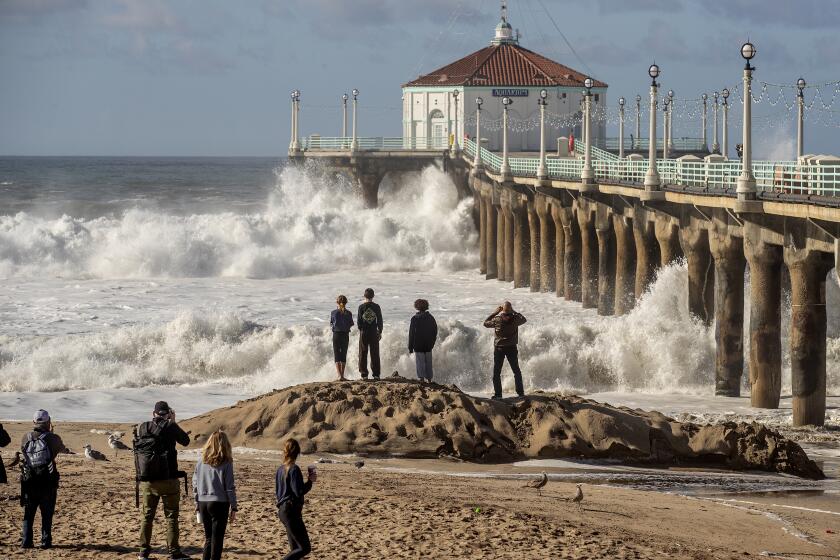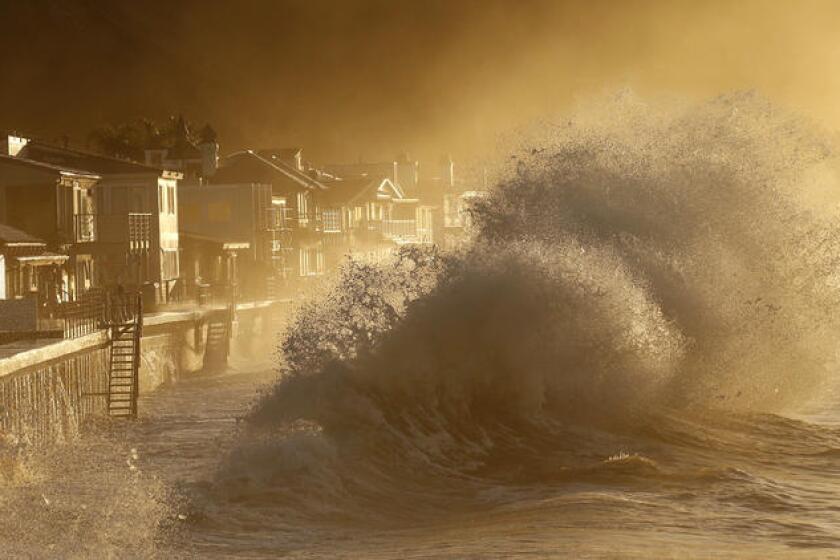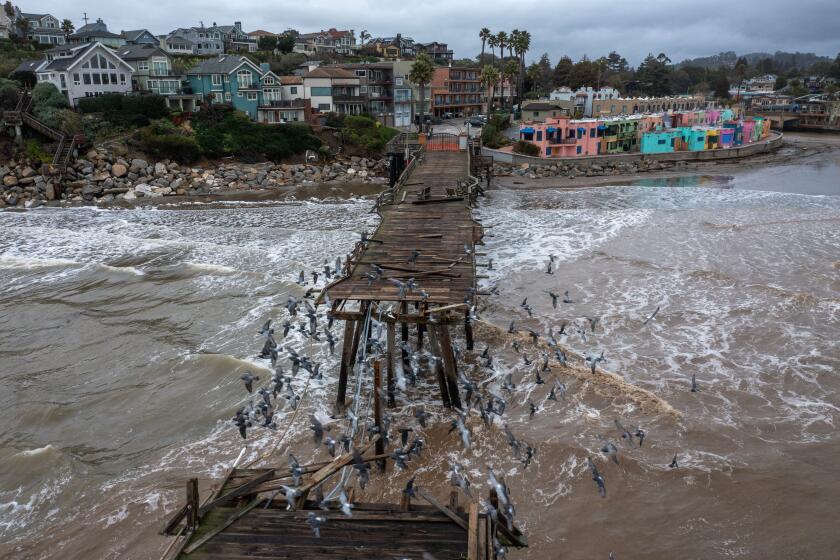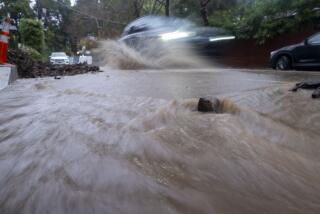Heavy surf pounds the Southern California coast, prompting warnings and shutting down piers
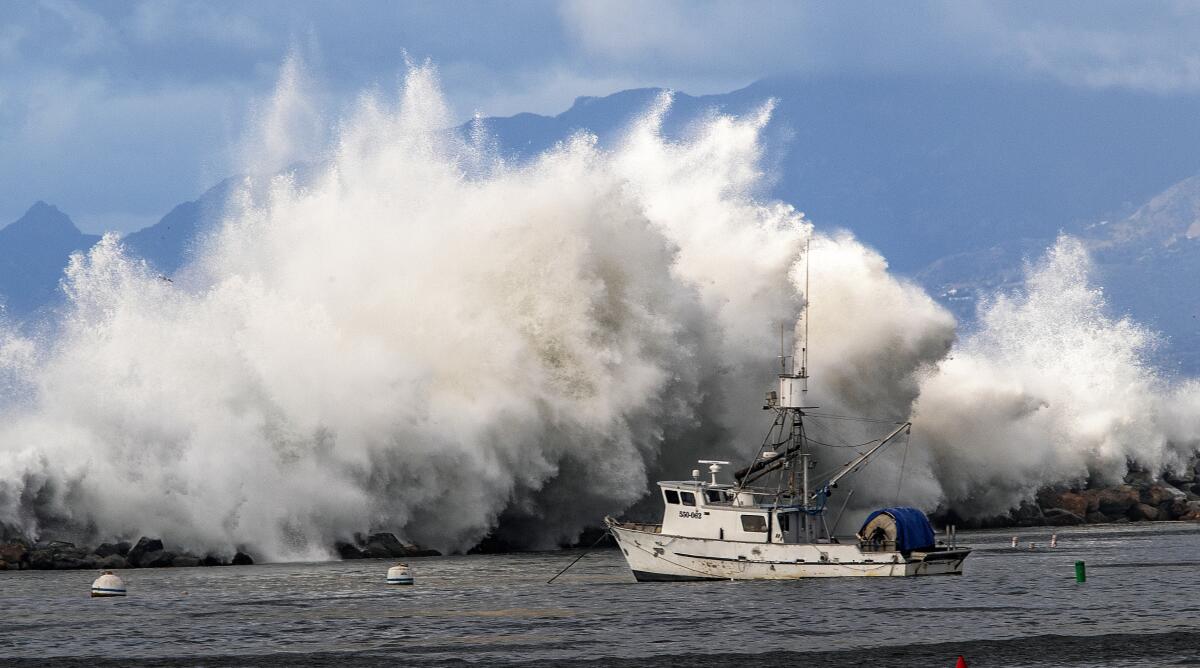
- Share via
Some of the heaviest surf in years pounded the Southern California coast on Saturday, while high tides triggered warnings of flooding and closures of beaches and piers.
Waves reached as high as 20 feet in Los Angeles and Ventura counties, while larger swells rolled in along the Central Coast and in Northern California. Officials warned that the powerful waves and strong surges could sweep people onto rocks and jetties and into the ocean.
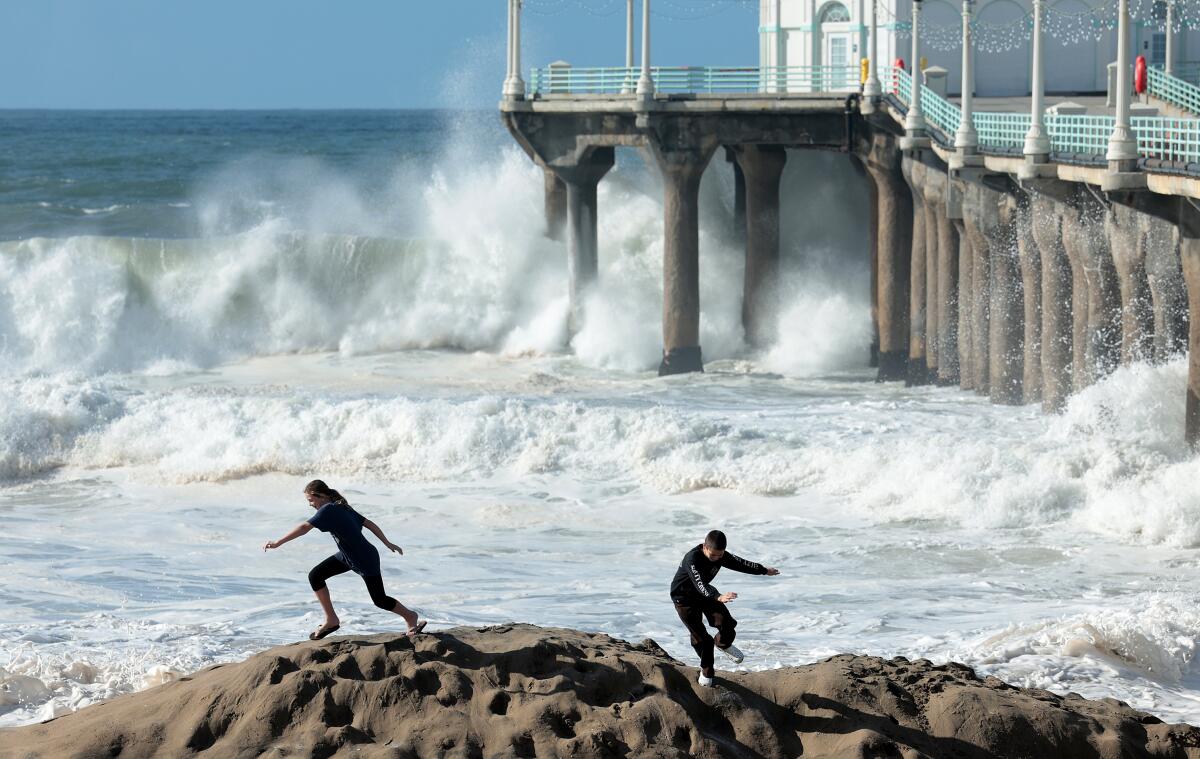
“It is generating extremely dangerous conditions at beaches,” said Rose Schoenfeld, a meteorologist with the National Weather Service in Oxnard.
“This is the highest surf we’ve had in the last year,” Schoenfeld said. “It’s definitely more like once every few years.”
The huge swells arrived while rain swept across Southern California on Saturday.
An initial round of strong waves pummeled the Ventura coast on Thursday, sending onlookers scrambling as the waves swept past seaside barriers and barreled down city streets. At least eight people were injured and several businesses were damaged as the waves broke windows and flooded buildings.
Saturday brought a second peak of hazardous waves. Residents with homes along Pacific Coast Highway in part of Ventura County were under an evacuation warning “due to high surf impacting structures in the area,” the Ventura County Fire Department said in a post on social media.
All beaches and coastal parks in Ventura County were closed Friday and were to remain closed over the New Year’s weekend.
The surging water flooded some parking lots in the area. And piers were closed from Ventura to Manhattan Beach.
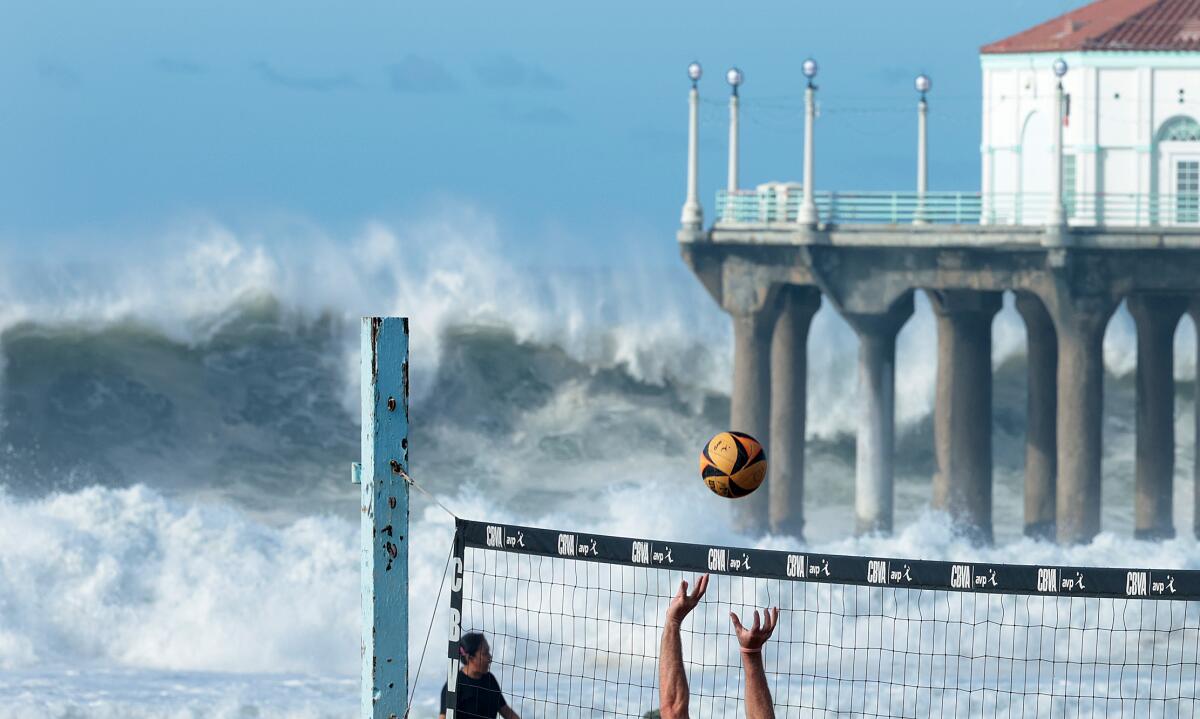
As powerful waves pummeled the shore, officials shut down the Venice Pier on Saturday. Crowds gathered along the sand berm, watching the biggest sets scrape the bottom of the structure. Huge walls of waves broke across the beach as storm clouds gave way to sunny skies.
“Definitely some of the biggest in years,” Venice surfer Tim Sullivan said of the heavy swell.
The pier is a popular surf spot, but no one dared to venture out — except an L.A. County lifeguard. The lifeguard maneuvered a jet ski across the whitewater and rode some of the larger waves, apparently practicing his rescue skills.
Rain and dangerous high surf are battering Southern California, prompting urgent safety warnings in coastal areas after damaging waves hit earlier this week.
Officials also warned people to be wary of “sneaker waves,” much like the one that caught Ventura beachgoers by surprise this week. The powerful waves are created by larger-than-average swells that can suddenly surge much farther inland than expected, breaking over rocks and lifting logs or driftwood onto the beach with deadly force.
The swells were generated by a low-pressure system to the north, west of Oregon, a few days ago. And the big surf combined with elevated high tides, which have been gradually decreasing after peaking Dec. 26, Schoenfeld said.
“It’s that combination of the really high surf with the fact that our tides are elevated in the lunar cycle right now,” Schoenfeld said. “We’ve gotten reports of pretty significant coastal flooding all up and down the coast.”
In the town of Capitola in Santa Cruz County, several seaside restaurants were damaged Thursday when the rising waters swept in.
“There was just a lot of water on our patio. There was some in our dining room, but we were able to get it mopped up and cleaned,” said Natalie Nelson, a host at Paradise Beach Grille on the waterfront. “We were able to open up for the weekend.”
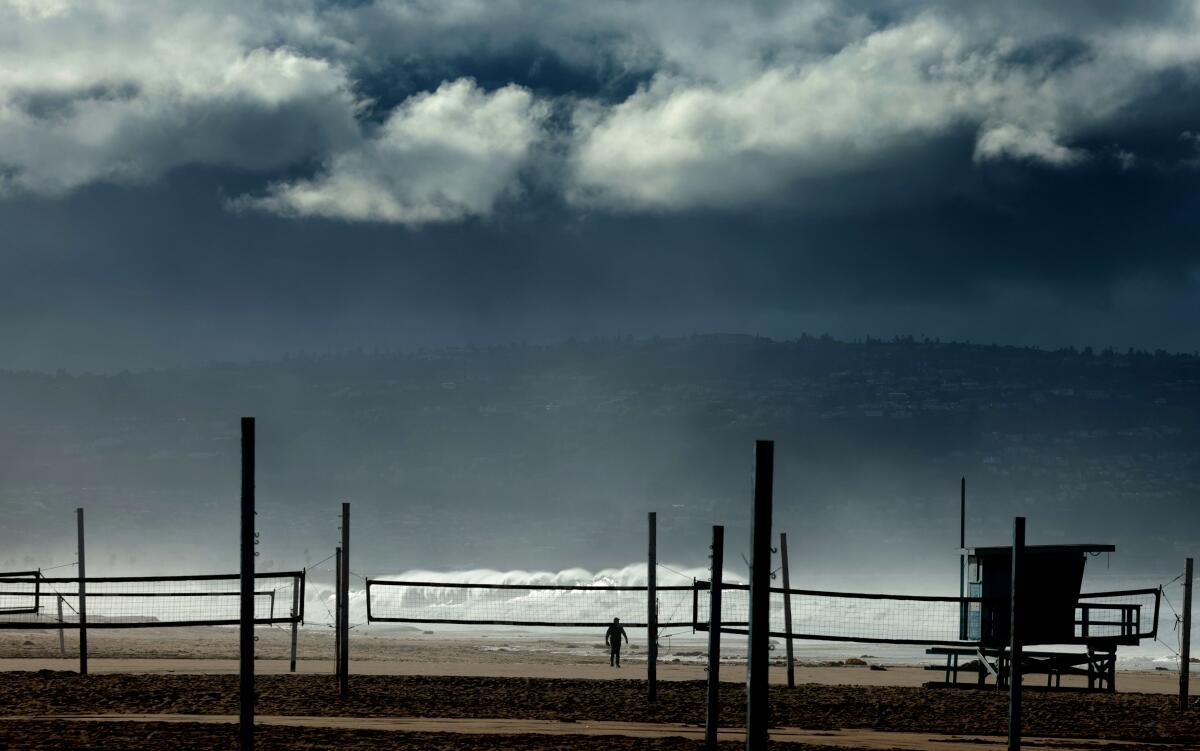
A video recorded in Capitola showed a woman swept from her feet by a surge of water, then helped to safety by another person.
Capitola Mayor Kristen Brown said one restaurant’s floor buckled when water came up underneath it. Another restaurant lost part of its deck, and other businesses were flooded.
“We did have some businesses and a few residents take on water. But what’s really been phenomenal is just since then, since Thursday morning, our public works crews have been out there just working beyond overtime,” Brown said. “The roads are all open now, at least to pedestrian traffic.”
It’s the second time in less than a year that Capitola has been damaged by flooding. In January, large waves and high tides destroyed parts of the town’s wharf.
Crews have been repairing the wharf, and some of the pilings were damaged again this time, Brown said, which probably will push up the estimated $8-million cost — a bill being footed by the city and its insurance as well as federal and state funds.
Still, the mayor said the damage from this storm turned out to be less than the last one in January. She said city workers had also prepared by clearing out drains and putting up sand berms to provide some protection against the waves.
Brown said with sea-level rise projected to make coastal flooding worse in the coming years, she and other city officials have been discussing preparedness efforts, as well as how the city can prioritize funding to adapt.
“We’re a really strong and resilient city,” Brown said. “We’ll continue to do our cleanup and support each other.”
This year, the flood potential along the coast has also increased partly because current El Niño conditions in the Pacific have raised the sea level on the California coast, said Brett Sanders, a UC Irvine professor of civil and environmental engineering who studies flood risks.
He said that’s one of several compounding factors, along with beach erosion and long-term sea-level rise driven by climate change, that in the coming years “will contribute to more coastal flooding events like the ones we’ve seen this weekend.”
“I think we have to be aware that there’s a lot of infrastructure and assets that are going to be exposed,” Sanders said. “There’s a need for coastal cities to plan a way out that works within the resources and values of those communities.”
On Saturday, warnings for heavy surf and coastal flooding were in effect throughout Southern California and the Central Coast. Forecasters said the highest surf and surges hit west- and northwest-facing beaches, such as Hermosa Beach and the Palos Verdes Peninsula.
The human-built world keeps getting in the way of the rising sea. But this current story of our coast does not have to end in disaster.
In Ventura and elsewhere, some surfers ventured into the giant waves as lifeguards kept watch.
Near San Francisco, the waves grew to massive over the last few days. The National Weather Service said breaking waves were forecast to reach as high as 33 feet along some Bay Area beaches on Saturday. That forecast was based on the largest waves that barreled in on Thursday, but Dalton Behringer, a National Weather Service meteorologist, said Saturday’s waves turned out to be a bit smaller — but still reaching more than 20 feet.
In Half Moon Bay, at the renowned surf break known as Mavericks, spectators gathered along the bluffs to watch surfers ride the giant waves. Nearby, at Old Princeton Landing restaurant and bar, employee Jon Dorn said surfers were continuing to paddle into waves on Saturday, though “it’s a little smaller than Thursday.”
Meanwhile, Saturday’s storm brought up to three-fourths of an inch of rain to Los Angeles and Ventura counties, while nearly 2 inches fell in Santa Barbara County, according to the weather service. Patchy showers were fading, while forecasters said mainly light rain is expected Sunday night into Monday.
In addition to the heavy surf, the storm brought other potential hazards to beaches. L.A. County’s Department of Public Health advised people to avoid contact with water through Tuesday because flowing storm drains and creeks can lead to higher levels of bacteria and chemicals.
Times reporters Karen Garcia, Christian Martinez, Ashley Ahn and Nathan Solis contributed to this report.
More to Read
Sign up for Essential California
The most important California stories and recommendations in your inbox every morning.
You may occasionally receive promotional content from the Los Angeles Times.
